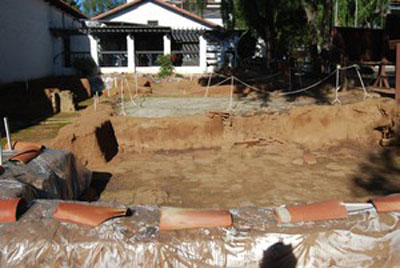
By Donald H. Harrison

SAN DIEGO—Chief docent Janet Bartel removed a barrier and stepped into the archaeological dig area at Mission San Diego, beckoning others to follow. Two sets of shallow pits, with a dirt walkway in between, were on the southwestern side of the mission quadrangle.
Approximately at the middle of the inner set of pits, Bartel stopped and indicated two columns. “Dr. Jack Williams (the supervising archaeologist) believes that this was the front of the mission—the front of the quadrangle. They would have greeted people over here.”
From that point, one could follow what might have been a narrow hallway out to the quadrangle. The rooms nearby were probably used by visiting Padres. “There would have been a library here,” Bartel said, motioning to a nearby area. “There are remnants of windows opening out to the courtyard.”
If this interior set of shallow pits was the entrance to the mission, then what about the second set of pits, closer to the present-day exterior wall? What were they?
“This is a forward extension dating from 1812 to 1813, when they were enlarging the mission,” Bartel responded.” In 1812, there was an earthquake that hit San Juan Capistrano (some 70 miles to the north.) So when they were building here, they put buttress wings up for stability. We believe the enlargement of this area was added at the same time.”
The rooms built in that enlargement probably were used by the U.S. military after 1848, when California was ceded to the United States by the Treaty of Guadalupe-Hidalgo.
A sign by the dig said: “We make discoveries every time we dig. In addition to many architectural features such as old floors, filled-in doorways and filled-in windows, we unearth a lot of artifacts. The upper layers are filled with objects left behind by the U.S. Army. For example, we have found the sole of an army shoe, a horse harness buckle, percussion caps, ration cans, and glass. We have also found many things that were used during the mission era. These include Chinese porcelain, tin-glazed pottery, shell beads, a spinning whorl, broken animal bones (from meals), charcoal, plainware pottery and stone tools. We also unearth large amounts of building rubble such as broken tile, adobe bricks, cement and wall plaster. Each of these items helps us to determine what life was like at the mission.”
Like a home whose residents are constantly remodeling, the mission underwent many changes. A temporary structure made of poles and reeds was burned to the ground in 1775, when Native Americans killed Father Luis Jayme. Thereafter it was decided to build with sturdier materials. “The new constructions were laid out in the shape of a square, surrounded by a fortified wall,” another sign instructed. “Over time, new adobe buildings took the places of older structures. By 1790 the fortifications had been eliminated. Each year, additional structures were added to the exterior of the quadrangle. San Diego Mission has had at least four different churches and three different conventos (living quarters). The convent before you is not the earliest, however it was clearly in use before 1810.”
In 1834, the mission era came to an end when the new government of Mexico stripped the Catholic Church of its mission holdings. Thereafter, according to the signs, “the population dramatically decreased, and many buildings soon fell into ruins. Despite the efforts of local settlers, priests and Indians, the complex had been completely deserted by 1846.”
“During the Civil War, the mission was given back to the Catholic Church” in a proclamation signed by President Abraham Lincoln. Bartel said she had the privilege of escorting U.S. Supreme Court Justice Antonin Scalia through the mission earlier this decade and he stopped by an enlargement of the proclamation signed by Lincoln, read it carefully, and commented that such a gift might “never fly” today, one assumes because of U.S. constitutional requirements governing the separation of church and state.
Objects that are unearthed at the site “are carefully washed and dried,” according to another on-site story board. “Every artifact is described and recorded. Some special objects are given more elaborate kinds of analysis. After they are cleaned and studied, the artifacts will be added to the holdings of the mission museum.”
Anticipating two questions of tourists and passers-by, the storyboards also say that neither riches nor human bodies have been found at the digs – nor would anyone expect to find either. At the missions, bodies were required to be buried in consecrated ground – which meant either under the floor of a church or in a cemetery. There are no records of either being at the western side of the quadrangle. As for riches, the signage informs: “The missionaries received a small stipend from the Spanish government in Mexico to support their efforts. However, the value of supplies, such as textiles, pottery and metal that were sent from Mexico, was deducted from those funds. Almost no coins were sent to the missionaries in California. Although they had taken vows of poverty, the Franciscans did possess as a group many fine objects for use in religious worship. When the missions were secularized in 1834, the friars took pains to see that these precious objects were entrusted to safe storage away from the mission.”
On the mission grounds is the Father Jayme Museum, where objects from the dig, along with photographs, objets d’art, and other memorabilia can be showcased. Paintings and photographs here, in the library and in other locations on the grounds, show the mission in its various iterations before its reconstruction in 1931.
The possibility of building a new museum on the southwestern side of the quadrangle is being considered, after the archaeological dig is completed. Typically digging occurs on Saturdays, with volunteers welcome to assist.
*
Harrison is editor of San Diego Jewish World. This article appeared previously on examiner.com